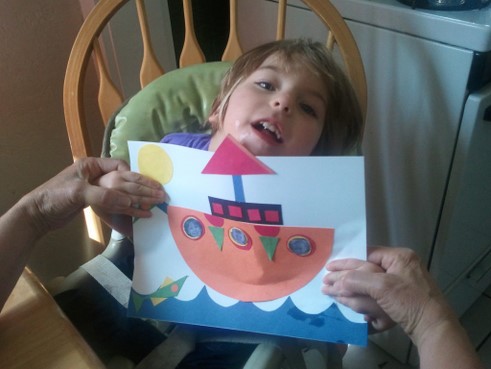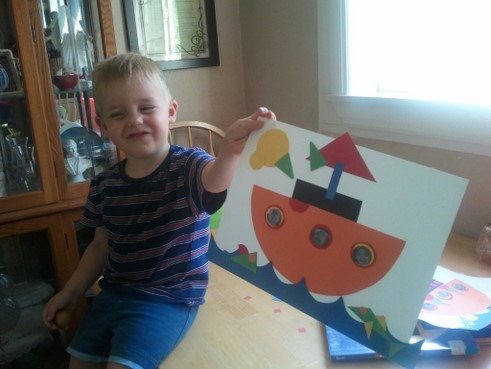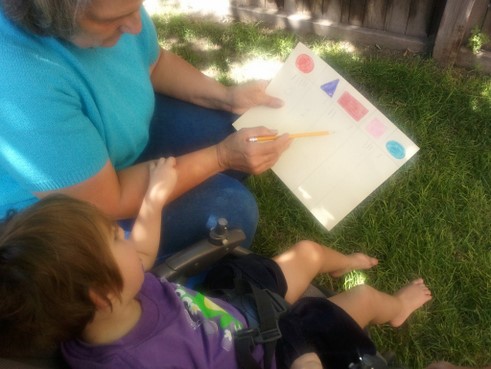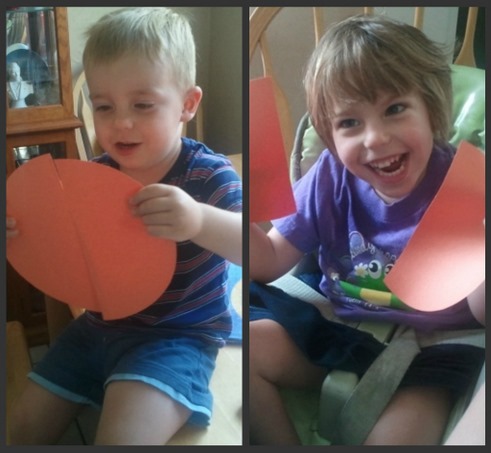As a child who sincerely tried but who was poor in math, geometry and algebra I was interested to learn that my failing might have been less an issue of ability and more an issue of lack of experience with spatial relationships and how shapes are used in the real world.
For young children, shapes are the building blocks to understanding math. In Math Art: Projects and Activities, author Carolyn Brunetto states, “Many children are simply better at understanding and retaining abstract mathematical concepts through physical experiences rather than through . . . drills.” Seeing and working with a variety of shapes in their environment enables children to form basic ideas about how math works.
Understanding shapes is also important to older children. Understanding shapes helps prepare children for higher mathematics.
We teach small children about two dimensional shapes like squares and circles which are used in plane geometry but we also need to teach older children about three dimensional shapes such as spheres, cubes and pyramids which are used in solid geometry. Did you know there are at least seven triangles that you can introduce your older children to?
In Grandma School this week The Traveling Closet was all about shapes, shapes used in geometry and other types of math. If you have very young children then you can do what we did. If you have children ages 8 and up I have given you some ideas for increasing your child’s awareness of spatial relationships and geometry shapes for kids below.
As always we started by looking at the cool books I had in my basket. I had some especially fine books this week that were so helpful to me that I didn’t have to look any farther for ideas.
The pictures in one of the books were so wonderful that we just copied them and made our shape creations based on that inspiration. (Shape Capers by Cathryn Falwell) There were shape cars, go carts, rockets, boats, people and a big dragon to choose from. As you can see we chose to make the boat and we put pictures of ourselves in the portholes. The kids loved that!
As we read this first book we talked about each shape, counted how many shapes on each page and talked about what they had created using shapes. Later we took a shape walk to discover for ourselves all the ways that shapes are used in our environment.
The idea for the walk came from another wonderful book from the library, Circus Shapes by Stuart Murphy. At the end of this book the author had two pages of ideas and ways that you can help your child have more fun with the math concepts presented in the book. We made a shapes game for kids to use as we walked.
We made a simple chart of shapes that we might see in our neighborhood. Then as we walked we made tally marks on our chart whenever we saw a shape. After our walk we counted the tally marks to see which shape we saw the most times and which shape we saw the least.
I will mention here that we couldn’t point out all the shapes we saw because three year old Jack got tired of the interruptions, and said “Lets get going”. So we just mentioned really good ones. If you have a mixed group of ages older children will want to have their own chart. You could have a contest to see who finds the most of any particular shape. You can encourage writing by having them list each item that they see. You could have a rule that you can only count a window, door or side walk square, etc. once.
We had shaped snacks which the children really enjoyed. We had oval hard boiled eggs, rectangle crackers and circle oranges.
I had made another shapes game which can be played over and over. I cut out lots of shapes and put them into a container. The children took turns reaching in and pulling them out and naming the shape.
By far the highlight of the day was when I showed them that they could make a circle from two half circles and that I could make a diamond from two triangles. Jack did it over and over again. He was amazed at this wonderful new discovery and was very excited by it.
Make learning math concepts fun and here are more ideas on teaching basic math concepts to preschoolers.
Activities for learning geometry shapes for older children while younger siblings learn their basic shapes:
- Create some of the 3-D shapes from the book Math Art: Projects and Activities by Carolyn Ford Brunetto
- Play Toothpick Squares (click this here for directions for all the games below)
- Play Penny Pyramid
- Solve the puzzle How Many Squares
- Have a contest called Triangulation
- Try your hand at Pencil Patterns
- Play the game Puzzles for Five Squares
- Do some creating with Geometrical Toothpicks
- Make a Geo Board
- Play Triangle Treat
- Have a basket of shapes your children are not familiar with such as Rhombus, Elipse, Pentagon, Hexagon, Octagon, Trapezoid, etc. Then play the identification game. Now use your paper shapes to make a picture.
- Use the shape identification game to learn about all the types of triangles and then create a picture using only triangles. For example Equilateral, Isosceles and Scalene.
Books on shapes for younger children:
- Shape Capers by Cathryn Falwell
- Circus Shapes by Stuart Murphy
- Shapes by Active Minds
- Round Like a Ball by Lisa Campbell Ernst
- The Shape of Things by Dayle Ann Dodds
- Color Zoo by Lois Ehlert
- Circles and Squares Everywhere! By Max Grover
Books on shapes for older children:
Go Fractions! by Judith Bauer Stamper – Although this isn’t a shape book it would be fun for older children to read or have the story read to them. Provide all the pieces of a circle that has been cut into fractions so that the child can take and add to the circle as they go through the story.
Math Art: Projects and Activities by Carolyn Ford Brunetto – This book has some activities which are shape related.
Why not take a moment and share this with another parent who is interested in inspiring their child by clicking the buttons below.
Possibly Related Posts:
- Teaching pre-math, reading, and music to children
- Kids Learn about Octopuses or Octopi
- Learning about Cows and activities for kids
- Teaching kids to sew can be educational and fun
- Easy Gingerbread Houses for Kids to Make








{ 3 comments… read them below or add one }
Love this post! Look at those gorgeos smiling faces 😉 I will share!
Oh thank you Kimberly. It was fun to write and share. That is one thing about you – you just keep coming back smiling despite those unexpected moments! : )
Kimberly, Hahahahah. This is one of those unexpected moments we have in life. I thought you were commenting on tomorrow’s post, which hasn’t even been published yet! It is about smiling through problems (like not knowing which post you just posted). I guess you’ll have to tune in tomorrow. Anyway, yes those were smiling faces even though we were doing some pre-geometry. : )